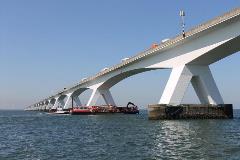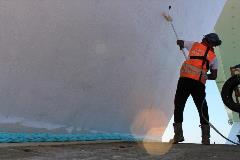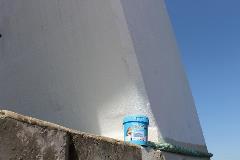Introduction:
• Preparation of the substrate;
• Protection of reinforcement rods;
• Positioning new reinforcement;
• Repairing concrete using thixotropic mortar;
• Repairing concrete using castable mortar;
• Repairing concrete using cementitious binders;
• Smoothing off concrete surfaces;
• Protecting and decorating concrete structures.
Each of these methods require different types of products, which are all suitable for achieving the required result, and the choice of which one of these to use depends on the location, the thicknesses to be repaired, on-site organisation, etc.
To make sure that repair work is efficient and long-lasting, having the most suitable products
available is not always sufficient. Deterioration to a structure may be due to a multitude of causes, and only if these causes are well known, may we be sure that repair work will be resistant and long-lasting. Regarding this issue, the diagnosis of deterioration is a fundamental phase in the list of operations to be carried out.
Through a detailed analysis of a structure it is possible, and also absolutely essential, to define the type of aggression, the penetration depth of polluting agents and the characteristics of the concrete used for the structure. After these operations, it is then possible to carry out the repair work.
Background
In 1962 the Province of Zeeland – an area in the south-western part of the Netherlands – decided to build a quick connection between the isles Noord-Beverland and Schouwen-Duiveland with the industrial area around the city Vlissingen-Oost, which was then going through a period of strong development. At the time, work on the Delta Plan project – a series of construction projects consisting of dams and infrastructures which have been protecting coastal areas from flooding since 1953 – was still in full swing. The Province of Zeeland, however, decided not to wait for the Oosterschelde dam to be built, which was to include a new road connecting various local towns, and went ahead on their own. The dam was completed in 1987, whereas the Zeeland Bridge had already been in service for more than twenty years: construction work on the bridge started in 1962 and it was inaugurated by Queen Juliana of the Netherlands on the 15th of December, 1965.
In order to recover the cost of the work, which had not received any form of state funding, from the inauguration date until the 31st of December 1992 anybody using the bridge, including pedestrians, cyclists and bus passengers, were required to pay a toll. In 2000 the road received a major overhaul to make it safer and bring it in line with the latest highway regulations and work included replacing the old guardrails on both sides of the road with concrete barriers and the introduction of a by-law that prohibited overtaking. On the 15th of December, 2015, the Zeeland Bridge was declared a Monument of National Interest by the Netherlands National Cultural Heritage Agency. The Zeeland Bridge is an imposing, 5,002-m-long structure and, up until the inauguration of the Öland Bridge in Sweden (6,072 metres long), it was the longest bridge in Europe. It is made up of 54 pillars and 52 spans of 95 m and has a mobile section 40 m long. The Zeeland Bridge, which has two lanes and a cycle lane, is suspended over the water and its entire length is supported by pillars in the form of an upside-down “V” placed on reinforced concrete bases which, in turn, sit on the seabed. The bases are of different lengths. Where the water is particularly deep they are 60 m long, while in other areas they are up to 30 m long. The bridge also has many different parts that are connected together by strong steel cables for a total length of 300 km.Before proceeding with painting the pillars, the concrete on some of the pillars was found to be badly deteriorated. Mapei Technical Services recommended removing the deteriorated areas until the reinforcing rods were exposed. It was recommended to apply two coats of MAPEFER 1K one-component, protective mortar on the reinforcing rods.
Once MAPEFER 1K had dried, the surface of the pillars was repaired with PLANITOP SMOOTH & REPAIR R4 structural, rapid-setting, shrinkage-compensated, thixotropic, fibre-reinforced mortar. The pillars were then finished off by applying two coats of ELASTOCOLOR WATERPROOF.
|
Product Name |
Description |
|
Elastocolor Waterproof |
A flexible, protective paint for outdoor applications made from acrylic resin in water dispersion |
|
Mapefer 1K |
One-component corrosion-inhibiting cement mortar for the protection of reinforcing rods |
|
Planitop Smooth and Repair R4 |
one-component, thixotropic mortar with very low emission of volatile organic compounds (EMICODE EC1 R Plus) |




Comments
Load more comments